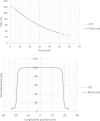Total body irradiation: A transition from a Co-60 treatment unit to an IMRT lateral-field extended-SAD technique
- PMID: 38952071
- PMCID: PMC11492311
- DOI: 10.1002/acm2.14430
Total body irradiation: A transition from a Co-60 treatment unit to an IMRT lateral-field extended-SAD technique
Abstract
Purpose: The purpose of this work was to detail our center's experience in transitioning from a Co-60 treatment technique to an intensity modulated radiation therapy (IMRT) based lateral-field extended source-to-axis distance (e-SAD) technique for total body irradiation (TBI).
Materials and methods: An existing beam model in RayStation v.10A was validated for the use of e-SAD TBI treatments. Data were acquired with an Elekta Synergy linear accelerator (LINAC) at an extended source-to-surface distance of 365 cm with an 18 MV beam. Beam model validation measurements included percentage depth dose (PDD), profile data, surface dose, build-up region and transmission measurements. End-to-end testing was carried out using an anthropomorphic phantom. Treatments were performed in a supine position in a whole-body Vac-Lok at an e-SAD of 400 cm with a beam spoiler 10 cm from the couch. Planning was achieved using IMRT, where multi-leaf collimators were used to modulate the beam and shield the organs at risk. Beam's eye view projection images were used for in-room patient positioning and in-vivo dosimetry was performed for every treatment.
Results: The percent difference between the measured and calculated PDD and profiles was less than 2% at all locations. Surface dose was 83.8% of the maximum dose with the beam spoiler at a 10 cm distance from the phantom. The largest percent difference between the treatment planning system (TPS) and measured data within the anthropomorphic phantom was approximately 2%. In-vivo dosimetry measurements yielded results within the 5% institutional threshold.
Conclusion: In 2022, 17 patients were successfully treated using the new IMRT-based lateral-field e-SAD TBI technique. The resulting clinical plans respected the institutional standard. The commissioning process, as well as the treatment planning and delivery aspects were described in this work with the intention of supporting other clinics in implementing this treatment method.
Keywords: TBI commissioning; TBI treatment planning; extended‐SSD IMRT; total body irradiation (TBI).
© 2024 The Author(s). Journal of Applied Clinical Medical Physics published by Wiley Periodicals LLC on behalf of American Association of Physicists in Medicine.
Conflict of interest statement
The authors declare no conflicts of interest.
Figures








References
-
- Wills C, Cherian S, Yousef J, Wang K, Mackley HB. Total body irradiation: a practical review. Appl Rad Oncol. 2016;5(2):11‐17. https://appliedradiationoncology.com/articles/total‐body‐irradiation‐a‐p...
MeSH terms
Substances
LinkOut - more resources
Full Text Sources

